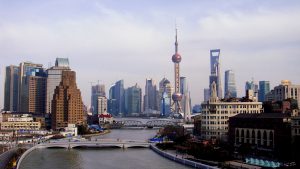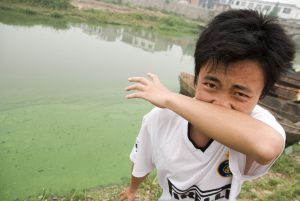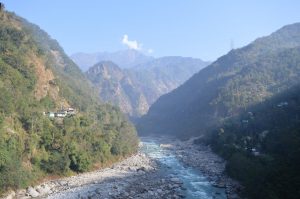Back in 2001, I met up with an ex-girlfriend whom I hadn’t seen since leaving college a decade earlier. We decided to go for a stroll along Shanghai’s Suzhou Creek, north of the city centre. What we did not foresee, however, was the untreated sewage from factories and residential areas lining the waterway; garbage dumped unceremoniously into the water from the docks; and diesel leaking from the 5,000 barges and boats that cruised down it every day. Indeed, the river smelled so bad that it ended our rendezvous ahead of schedule.
Winding more than 30 miles across the city, Suzhou Creek first started to stink in the 1920s, as Shanghai’s textile factories sprung up along this major shipping artery. Water quality deteriorated further in the ’60s and ’70s, so much so that families in houses overlooking the water never opened their windows – even in the summer.
While in the US in 2006, I took a train to Washington, D.C. When the train crossed the Potomac River in Maryland, I saw men in suits kayaking in the water below, obviously on their way to work. It was one of the most wonderful moments of my travels in the US, given my negative impression of rivers in China.
For over three decades, the problem with Shanghai’s waterways has not been whether one could swim or kayak in them, but whether one could bear to breathe the air around them. During the worst stage of contamination, up to 1,000 factories and three million people living on its banks pumped 600,000 tonnes of industrial and domestic sewage into the Suzhou Creek every day.
Between 1998 and 2008, the Suzhou Creek was reborn, thanks to initiatives that dredged up silt, diverted sewage, built water treatment facilities, demolished docks, and pumped oxygen into the river. Now, not only is the smell of fetid water a thing of the past, but fish and turtles have also returned to the waterway. Since 2001, there has even been a boating competition held in honour of the Dragon Boat Festival every May.
However, Shanghai’s waterways are still far from pristine. Apart from the Suzhou Creek and the Huangpu River – the last major tributary of the Yangtze River before it flows into the East China Sea – there are 195 smaller rivers and 26,300 streams across the city, most of which still bear the marks of mild to severe pollution. According to official reports on the state of Shanghai’s environment, in 2015, the water quality of nearly three-quarters of the urban waterways was as poor as Suzhou Creek used to be in the late ’90s.
For over three decades, the problem with Shanghai’s waterways has not been whether one could swim in them, but whether one could bear to breathe the air around them.
New momentum in the fight to revitalise Shanghai’s waterways has come from the State Council, China’s cabinet, which announced a road map to control water contamination in April 2015. The initiative has made it a national goal to halt the deterioration of water quality by 2020, and at the top of that agenda sits the need to protect urban waterways.
Back in late 2015, the Shanghai Water Authority identified 56 city streams as excessively polluted and made them priority targets for cleaning. The municipal water bureau periodically publishes clean water updates on its website and can only conclude its cleaning operations once a minimum of 90% of people contacted for public consultation are pleased with the state of the rivers.
In Shanghai, local governments are linking their battle against water pollution with a two-pronged drive to demolish housing designated for clearance and expel unwanted migrants on the city’s outskirts. In Xupu village, situated in a western suburb of Shanghai, the population density was once a whopping 43,000 people per square kilometre, with many residents treating the little river that runs through the village as their sewage outlet and garbage dump.
After closing 256 local factories – which, incidentally, cost 13,000 labourers their jobs – the river in Xupu village is now clean again. Today, an enormous poster on the bank of the reincarnated river identifies the so-called river chief, complete with his name, job description, and action plan. In Shanghai, top officials from all levels of government serve as “chiefs” of polluted rivers in their jurisdictions and are held personally accountable for keeping them clean. Beginning in 2017, information on which officials are responsible for the upkeep of which rivers will be made publicly available on the websites of Shanghai’s municipal authorities, so that complaints can be forwarded directly to officials in charge.
River chiefs are responsible for watercourses much like mayors and county or district heads are responsible for their jurisdictions. Having been rolled out across the country in recent months, the river chief system aims to bring long-term conservation to Chinese rivers. Yet one major flaw is that the scheme trumpets the rule of man, not the rule of law.
The system brings great efficiency, with the highest-ranking officials at each level of government driving policy execution, but it backfires when economic concerns outweigh environmental protection. Most heads of government, simultaneously responsible for both pollutant reduction and gross domestic product growth, constantly struggle to maintain this balance. Therefore, the river chief system is at best an interim plan. Ultimately, the true driver of progress has to be the rule of law.
Another drawback is that the system places constraints on public participation. With the river chief in the spotlight and public onlookers on the sidelines, the battle against dirty rivers could become a political crusade determined by the arbitrary will of individual officials, instead of a sustainable campaign built on informed consent and public advocacy.
In addition, officials serve according to government terms, which last five years in China. During the official changeover period, past plans – including river cleanup programmes – are frequently shelved, and promises made by former chiefs are rarely acted upon by their successors.
More than river chiefs, China needs to set scientific parameters determining the maximum pollutant levels permissible for its rivers to be considered clean. Moreover, only when river chiefs respect the rule of law can their powers be kept properly in check. Like government officials in most parts of China, their performance evaluations depend more on how well they manage the economy than on how well they protect the environment. For China’s waterways to make a truly sustainable recovery, we will need to see a dramatic change in official attitudes to reflect greater respect for the rule of law.
This blog is republished with permission from Sixth Tone








